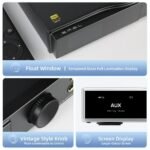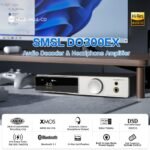Looking to get the most out of your audiophile headphones? Well, you’ve come to the right place! In this article, we’ll explore the best audio sources to enhance your listening experience and take your music to a new level. Whether you’re a casual listener or a dedicated music enthusiast, we’ve covered you with tips and recommendations to help you achieve optimal performance with your headphones. So, elevate your audio game and immerse yourself in high-fidelity sound!
Are you curious to know which audio sources will make a difference when paired with your audiophile headphones? We’ve got all the answers for you! This article will explore various options, such as uncompressed music files, high-resolution streaming services, and dedicated audio players. We’ll discuss each source’s benefits and compatibility with different headphone models and provide you with some top-notch recommendations to get started. So, stay tuned, and let’s dive into the world of audiophile audio sources that will revolutionize how you listen to music!
Understanding Audiophile Headphones
Audiophile headphones are specially designed to provide an immersive and high-fidelity audio experience. Whether you are a casual listener or a professional music producer, choosing the right audio source is crucial for achieving optimal performance with your audiophile headphones. This article will explore the different types of audiophile headphones, their characteristics, and the importance of audio sources in enhancing sound quality.
Types of Audiophile Headphones
Audiophile headphones come in various types, each offering a unique listening experience. The most common types include:
- Open-back headphones have earcups with perforated or gridded panels that allow sound to escape. They offer a spacious and natural soundstage but have limited noise isolation.
- Closed-back headphones have sealed earcups that prevent sound leakage and improve noise isolation. They are ideal for critical listening in environments with high ambient noise.
- In-ear monitors (IEMs) are compact earphones that fit snugly inside the ear canal. IEMs offer excellent noise isolation and are highly portable, making them suitable for on-the-go listening.
- Planar magnetic headphones use a unique driver technology called planar magnetic drivers. They deliver a highly detailed and accurate sound reproduction but can be quite expensive.
Characteristics of Audiophile Headphones
Audiophile headphones are known for their superior audio quality and specific characteristics that set them apart from regular headphones. Here are some key characteristics to consider when choosing audiophile headphones:
- Frequency response: The frequency response range indicates the headphones’ ability to reproduce different frequencies accurately. Look for headphones with a wide frequency response range to experience a broader range of audio frequencies.
- Impedance and sensitivity: Impedance measures the electrical resistance of the headphones, whereas sensitivity determines how loud the headphones can get. Low-impedance headphones are more suitable for portable devices, while high-impedance headphones require a dedicated amplifier to achieve optimal performance.
- Soundstage: Soundstage refers to the perception of space and separation in audio. Audiophile headphones with a wide soundstage provide a more immersive listening experience by accurately reproducing positional cues in the audio.
- Detail and clarity: Audiophile headphones are appreciated for their ability to reproduce audio with exceptional detail and clarity. Look for headphones that can accurately reproduce intricate instrument separation, vocals, and other audio nuances.
Importance of Audio Sources
While choosing high-quality audiophile headphones is essential, your audio source can significantly impact the sound quality and overall listening experience. Let’s explore the importance of audio sources and how they can affect the performance of your headphones.
Impact of Audio Sources on Sound Quality
The quality of the audio file and the device playing it can significantly influence headphone performance. Low-quality audio files, such as highly compressed MP3s, often lack detail and dynamic range compared to lossless formats or high-resolution audio files. Similarly, using a device with inferior audio processing capabilities can limit the true potential of audiophile headphones.
Choosing the Right Audio Source
It is crucial to use high-quality audio sources to optimize the performance of your audiophile headphones. Here are some recommended audio sources for achieving optimal sound quality:
- Lossless audio formats: Lossless audio formats, such as FLAC (Free Lossless Audio Codec) and ALAC (Apple Lossless Audio Codec), preserve the original audio quality without any loss in fidelity. You can use lossless audio formats to ensure that every nuance and detail in the music is faithfully reproduced.
- High-resolution audio: High-resolution audio files offer an even higher level of audio quality than CD-quality audio. These files have a higher sampling rate and bit depth, more accurately representing the original recording. Websites and online stores specializing in high-resolution audio offer a vast collection of music catered explicitly to audiophiles.
- Digital audio players: Dedicated digital audio players (DAPs) are designed to deliver high-quality audio playback. They often feature superior digital-to-analog converters (DACs) and amplifiers, reducing interference and ensuring optimum sound quality. Some DAPs also support various lossless and high-resolution audio formats.
Digital Audio Sources
Digital audio sources have become increasingly popular due to their convenience and accessibility. Let’s explore some digital audio sources that pair well with audiophile headphones.
Lossless Audio Formats
As mentioned earlier, lossless audio formats are ideal for preserving the original audio quality. Digital music libraries or streaming platforms offering lossless audio formats allow listeners to enjoy high-quality music without compromising fidelity. Several music players and apps support the playback of lossless audio formats, giving you a wide range of options.
High-Resolution Audio
High-resolution audio takes digital audio quality to the next level. With higher sampling rates and bit depths, high-resolution audio provides a more detailed and accurate sound reproduction. Many online music stores now offer high-resolution audio downloads or streaming services, giving audiophiles access to an extensive library of high-quality music.
Digital Audio Players
Dedicated digital audio players (DAPs) are purpose-built devices that provide excellent audio quality. These devices often include high-quality DACs, amplifiers, and advanced circuitry to minimize interference and provide a clean audio signal. Some DAPs also have additional features like support for lossless audio formats, high-resolution playback, and expandable storage options.
Analog Audio Sources
While digital audio sources have gained prominence, analog audio sources hold a special place in the hearts of many audiophiles. Let’s explore some analog audio sources that can complement your audiophile headphones.
Vinyl Records
Thanks to their warm and authentic sound, vinyl records have made a remarkable comeback in recent years. Audiophiles appreciate the unique tonal characteristics and the tactile experience of handling vinyl records. Pairing high-quality turntables with audiophile headphones creates an immersive and nostalgic listening experience.
Tube Amplifiers
Tube amplifiers, also known as valve amplifiers, are favored by many audiophiles for their distinct audio reproduction. These amplifiers use vacuum tubes instead of transistors to amplify the signal, resulting in a warmer and smoother sound signature. Pairing tube amplifiers with audiophile headphones can add a touch of vintage charm and enhanced audio performance to your listening sessions.
Streaming Services
Streaming services have revolutionized the way we consume music. Let’s explore how streaming services have adapted to cater to the needs of audiophiles.
Lossless Streaming
As the demand for high-quality audio grows, streaming services have started offering lossless streaming options. Lossless streaming ensures that the audio remains intact throughout the transmission, allowing audiophiles to enjoy their favorite music in the best possible quality. Services like Tidal and Qobuz offer lossless streaming plans specifically targeted toward audiophile listeners.
Hi-Res Audio Streaming
Some streaming platforms have introduced subscription plans that offer access to a vast library of high-resolution audio content. These platforms use advanced audio encoding techniques to deliver studio-quality audio to audiophile headphones. Apple Music, Tidal, and Amason Music HD lead hi-res audio streaming.
Audio Interfaces
Audio interfaces are crucial in achieving optimal sound quality, mainly when using a computer or other digital devices as your audio source. Let’s explore some standard audio interfaces used for audiophile listening.
External DACs
External digital-to-analog converters (DACs) are commonly used to enhance audio quality when connecting headphones to digital devices. These DACs bypass the internal DAC of your device, allowing for a cleaner and more accurate audio signal conversion. Many external DACs also support high-resolution audio playback and offer various input and output options.
USB Interfaces
USB interfaces connect your audiophile headphones to your computer or other digital devices. These interfaces typically offer enhanced audio performance compared to the standard headphone outputs found on most computers. USB interfaces can also provide features such as multiple outputs, balanced connections, and improved amplification.
Computer Audio
If you primarily use a computer as your audio source, a few considerations exist to optimize your listening experience.
Using a Dedicated Sound Card
A dedicated sound card can significantly enhance the audio quality of your computer. These sound cards often feature high-quality DACs, improved circuitry, and advanced audio processing capabilities. Installing a dedicated sound card can reduce interference and provide a cleaner audio signal, improving sound quality when using audiophile headphones.
Optimizing Audio Settings
Adjusting the audio settings on your computer can have a noticeable impact on sound quality. Some settings include selecting the correct audio output device, adjusting sample rates and bit depths, and ensuring that sound enhancements are disabled. Experimenting with different settings can help you achieve the best audio performance with audiophile headphones.
Mobile Devices
Many prefer mobile devices as their primary audio source due to their portability and convenience. Let’s explore how you can optimize sound quality using audiophile headphones on mobile devices.
Choosing the Right Mobile Device
Not all mobile devices are created equal when it comes to audio performance. Look for devices with a dedicated audio processor, high-quality DAC, and capable amplification. Some manufacturers pay extra attention to audio quality in their devices, offering features like Hi-Fi DACs or stereo speakers to enhance the audio experience.
Using External DACs with Mobile Devices
To further improve the audio quality of your mobile device, you can use an external DAC or portable headphone amplifier. These devices connect to your mobile device via USB or other digital interfaces, bypassing the internal audio processing and providing a cleaner audio signal. Portable DACs often offer features like MQA decoding, DSD playback, and balanced output options.
Listening Techniques
Listening techniques play a crucial role in maximizing the performance of your audiophile headphones. Here are a couple of essential techniques to enhance your listening experience:
Critical Listening
Critical listening involves actively focusing on the music, paying attention to details, and analyzing the sound quality. By training your ears to recognize subtle differences in audio reproduction, you can better appreciate the capabilities of your audiophile headphones and identify any areas for improvement in your audio setup.
Room Acoustics
The acoustics of your listening environment can significantly impact the sound quality. Consider room size, furniture placement, and acoustic treatment to optimize the listening experience. Acoustic panels, diffusers, and bass traps can help minimize unwanted reflections and resonances, resulting in a more accurate and enjoyable listening experience.
Conclusion
Selecting the best audio sources for optimal performance with audiophile headphones is crucial in fully experiencing the capabilities of your headphones. Choosing the right audio source, whether lossless audio formats, high-resolution audio, vinyl records, or streaming services, can significantly enhance your listening sessions. Additionally, external DACs, optimizing computer audio settings, and using mobile devices with dedicated audio processors can improve audio quality.
By considering these factors, experimenting, and critically listening, you can achieve an immersive and high-fidelity audio experience with audiophile headphones. Invest in quality audio sources and enjoy the wonders of music in its purest form!










